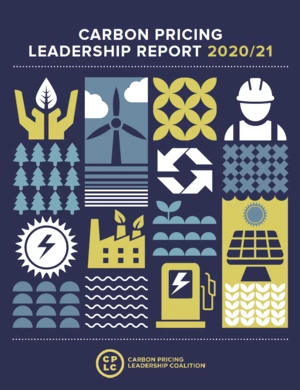This year's Carbon Pricing Leadership Report comes as much of the world continues to grapple with the global COVID-19 crisis that has ravaged communities , overwhelmed health care systems, closed borders, and brought economies to a near halt over the past year. As future generations look back at this time, they will see this pandemic as one of humanity's greatest tragedies, but they will also see our resilience. Through collaboration and collective action, we now need to focus on building back better and set a path toward green, resilient and inclusive development in the long term.
Like COVID-19, the climate crisis does not stop at borders, and we need the same level of urgent and decisive action. Despite the global health crisis, 2020 saw the largest alliance of countries and corporations committing to achieving net-zero carbon emissions by 2050 as part of the United Nations Race to Zero campaign. These commitments now cover at least 68% of the global economy, 56% of the global population (over 4.2 billion people), and 61% of global greenhouse gas emissions. Our job now is to mobilize this surge of commitment and turn it into action to meet the enormous task at hand.
"We are at a unique moment at which putting a price on carbon can power a resilient, inclusive, and sustainable post-pandemic recovery and help set countries on a low-carbon growth path."
Over the last decade, the number of national and subnational jurisdictions with explicit carbon pricing systems has roughly tripled. Collectively, they price about one-quarter of global carbon emissions. But the current levels fall well short of achieving national and international climate objectives. Carbon pricing often encounters political challenges, and the current average explicit carbon price in the world economy is estimated at just $2 per ton of CO2. The 2017 Stern-Stiglitz Commission on Carbon Pricing found that carbon prices should rise to between $50 and $100 per ton of CO2 by 2030, to meet the Paris Agreement targets cost-effectively.
We are at a unique moment at which putting a price on carbon can power a resilient, inclusive, and sustainable post-pandemic recovery and help set countries on a low-carbon growth path. Through the combination of macro-fiscal, sectoral, and technical expertise, along with our convening power, the World Bank is uniquely placed to support the development and implementation of carbon pricing. The Partnership for Market Readiness helped 23 countries introduce carbon pricing; its successor facility, the Partnership for Market Implementation, is gearing up to support more than 30 countries. The Energy Subsidy Reform Facility supports country programs to reduce negative carbon prices through fuel subsidy reforms.
The Carbon Pricing Leadership Coalition (CPLC) provides a powerful platform to convene the private sector, governments, and civil society on carbon pricing to harness public-private collaboration to advance climate action and achieve sustainable development. For five years, CPLC's platform has provided an opportunity for a broad range of countries, the private sector, and stakeholders to share their best practices, disseminate essential research, amplify their leadership, and inspire others to follow suit.
Over the last 12 months, CPLC has engaged stakeholders through high-level dialogues and regional workshops in Asia, the Middle East, Africa and the Americas, to examine how carbon pricing can contribute to strategies for sustainable recovery, enhanced NDCs as well as the achievement of net zero. The Coalition has a growing number of new partners and continues to mobilize engagement, focusing on developing countries. I am happy to note that the Coalition recently convened a Net-Zero expert task force to further the understanding of how putting a price on carbon can help achieve the growing ambition to reach net-zero by mid-century. I look forward to the release of the Coalition’s report ahead of COP 26 to build momentum to reach the Paris Agreement targets.
The decarbonization shift is underway. Green recovery is a win-win solution that can trigger much needed investment for a transition to a low carbon economy and a net zero future , but much more action on a broader scale is needed to realize inclusive and resilient recovery. CPLC marked its fifth year of operation in 2020-21. This year's leadership report takes stock of progress made, emerging trends, developments, and challenges in the global carbon pricing landscape. It also showcases leadership action from its partners, highlights public and private sector carbon pricing mechanisms that drive sustainable growth and build resilience, and shares insights from thought leaders. I hope the perspectives shared in the report inspire and encourage decision-makers to incorporate carbon pricing into economic decision-making, take near-term action and aim for a net zero future.
This piece appears as the foreword of the Carbon Pricing Leadership Report 2020-21. The full report is available for download here.



Join the Conversation